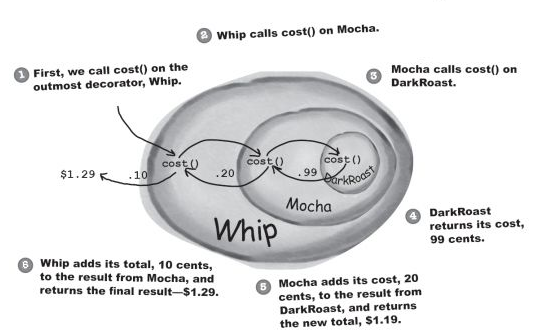
Decorator Pattern
Objectives
During this activity:
- Students will write and test Ruby code that implements the Decorator pattern.
This activity helps students develop the following skills, values and attitudes: ability to analyze and synthesize, capacity for identifying and solving problems, and efficient use of computer systems.
Activity Description
This activity can be developed individually or in pairs.
This example was taken from [FREEMAN] pp. 79-98.
-
Create a directory called
decoratorand a subdirectorysrcwithin it. Inside thesrcfolder create two files called:coffee.rb, andcoffee_test.rb.All Ruby source files must start with a comment containing title, date, and the authors' personal information. For example:
# Decorator Pattern # Date: 18-Mar-2019 # Authors: # A00456654 Thursday Rubinstein # A01160611 Anthony Stark
-
Write the code that allows us to model coffee beverages using the Decorator pattern. The following tables show what beverages and condiments are available, and their corresponding prices:
Beverages Name Price Dark Roast Coffee $0.99 Espresso $1.99 House Blend Coffee $0.89
Condiments Name Price Mocha $0.20 Whip $0.10 Soy $0.15 Milk $0.10 In our design, the condiments will decorate the beverages. The following Ruby code demonstrates how your code could be used:
beverage = DarkRoast.new beverage = Mocha.new(beverage) beverage = Whip.new(beverage) puts beverage.description puts beverage.cost
For this example, the expected output should be:
Dark Roast Coffee, Mocha, Whip 1.29
The following image depicts the way the decorators work when the
costmethod is called from the above code.
The following UML diagram shows the class hierarchy. Each class needs to implement one or several of these methods:
initialize,description, andcost.
All these classes should be placed in the
coffee.rbsource file. -
The following unit tests verify the correct behavior of your classes. Place the test class in the
coffee_test.rbsource file.# File: coffee_test.rb require 'minitest/autorun' require 'coffee' class CoffeeTest < Minitest::Test def test_espresso beverage = Espresso.new assert_equal("Espresso", beverage.description) assert_equal(1.99, beverage.cost) end def test_dark_roast beverage = DarkRoast.new beverage = Milk.new(beverage) beverage = Mocha.new(beverage) beverage = Mocha.new(beverage) beverage = Whip.new(beverage) assert_equal("Dark Roast Coffee, Milk, Mocha, Mocha, Whip", beverage.description) assert_equal(1.59, beverage.cost) end def test_house_blend beverage = HouseBlend.new beverage = Soy.new(beverage) beverage = Mocha.new(beverage) beverage = Whip.new(beverage) assert_equal("House Blend Coffee, Soy, Mocha, Whip", beverage.description) assert_equal(1.34, beverage.cost) end end
- Write and generate your program’s documentation as described in: Documenting Ruby Programs.
Deliverables
Create a compressed tarball file with the full contents of the decorator directory (including the generated HTML documentation in the doc subdirectory). Call this file decorator.tgz. From a terminal, you can use the following command to create this file (make sure to run it at the same level where the decorator folder resides):
tar czf decorator.tgz decorator
Upload Instructions
To deliver the decorator.tgz file, please provide the following information:
Only one team member needs to upload the file.
Due date is Monday, March 18.
Evaluation
This activity will be evaluated using the following criteria:
| 50% | Implementation of program requirements. |
|---|---|
| 50% | Documentation. |
| 1 | The program and/or documentation was plagiarized. |